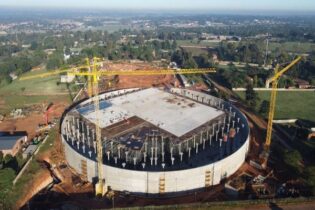The uMhlatuze Municipality project, which recently won a CMA award ,involved the installation of 8 470of Rocla’s Ventilated Improved Double-Pit (VIDP) toilets, which were assembled using precast concrete panels. Chantelle Mattheus unpacks the project challenges at length with Rocla representatives.
“This phase of the project formed part of the Department of Water Affairs’ Sanitation for a Healthy Nation plan,” explains Simon Wells, Rocla’s business manager of Sanitation. According to Craig Waterson, Rocla’s marketing director, this was the third phase of a project that formed part of the Department of Water Affairs’ Sanitation for a Healthy Nation plan.“Close liaison with local communities ensured that the quality and toilet placement requirements were met,” says Waterson. Waterson believes the project’s uniqueness lies in the fact that the end results are high-quality, durable sanitation units that were manufactured on the site with significant community involvement. He adds that while Rocla was not initially involved with Phase 1 of the project, it acquired the company D&D that was responsible for Phase 1 approximately six years ago while it was still busy with that contract.“Rocla successfully tendered using a purpose-designed improved solution and was awarded Phase 2 and 3. The Rocla product is well accepted and is now an integral part of the rural sanitation landscape of the district,” says Waterson. The project started in March 2011 and was completed in January 2013 Purpose designed The Rocla sanitation units were purpose designed to meet the “double pit” requirements specified in the contract by the company, in conjunction with the uMhlathuze District Municipality and the consulting engineers, in accordance with the technical requirements of the area. The system utilises sophisticated moulds and fabric reinforcement to create lightweight panels.“The advantage of this technology is that the number of elements and consequently number of joints involved in each structure is minimised. The factory can be easily erected close to the project area and the manufacturing process is simple and tailored to be labour intensive to provide employment to members of the local community,” explains Waterson. He adds that other innovations included in the design were a stainless steel door and child safe locking mechanism, which makes it impossible to be locked inside the structure. In addition, according to Waterson, the use of precast concrete panels ensured a high-quality end product, and a simple yet highly effective design ensured ease of assembly and best practice installations. On-site skills trainingOn-site skills training was provided during the project for bricklayers, welders and security guards, among others, as well as relating to computer skills, health and safety in the work place, basic business principles and stores control. “Rocla, in conjunction with the uMhlathuze District Municipality provided SETA-approved training, which equipped the trainees with skills for further employment opportunities,” says Waterson, adding that local community residents were involved in all facets of the operation, from the digging and lining of the pits to the manufacture and installation of the toilet units.
The panels were manufactured in a factory, purpose built by Rocla at Port Durnford, employing approximately 390 local community members of which 70% were women. “We were proud to win this award as the judging criteria and evaluation in this category were strict and a careful process decided on factors such as job creation, sustainable skills transfer to the local community, design innovation, installation and product quality,” states Wells. A total of 177 local community members were employed in the factory and nine local BEE subcontractors transported the concrete panels, built the latrine pits and erected the toilets. The project consumed approximately 7 000 t of concrete for the sanitation structures and 1.1 million concrete blocks to line the pits. “All raw materials, building materials, services and equipment were sourced from local business where available,” concludes Waterson. CMA Award winning innovation Rocla was the only contender that walked off with two CMA awards in different categories at the recent prize-giving ceremony. Craig Waterson, Rocla’s marketing director says: “The two trophies were a huge morale boost for everyone at Rocla, as they not only confirmed our position in the infrastructure sector as a preferred partner in the supply of precast concrete products, but also bear testament to more than 90 years of industry experience in Southern Africa.” Rocla, a manufacturer of precast concrete, received recognition in the Community Excellence category for its uMhlatuze District Municipality Rural Sanitation Phase III, Northern KwaZulu-Natal project. The other award was for the Ingula Pumped Storage Scheme – KZN/Free State border project in the Technical Excellence category, “both of which illustrate the company’s commitment to provide custom-made, high-quality concrete products using the latest technologies and innovations.” The Ingula Pumped Storage Scheme project that won the award for innovative technical merit entailed the design and construction of a permanent precast shuttering solution, instead of deploying a traditional shuttering system. The project faced challenging constraints, such as confined space and limited access to the underground works to support a 400 t gantry crane in the electricity generator hall. The engineers assembled and reinforced 552 of Rocla’s concrete columns, beams and corbel elements in 38 product modifications on-site. These elements vary in weight up to 8 t a piece and 1.5 to 11 m in length. Extremely tight tolerances of 3 mm for linear dimensions and about 2 mm for vertical alignment were met through stringent quality control measures. The manufacturing process that Rocla undertook was complex. For example, male joints needed to be cast into the upper ends of each column and female joints into the bottom ends due to the design of the concrete shutter. “The challenge of handling these complexities meant designing for all possible scenarios to accommodate each column’s unique centre of gravity,” explains Waterson, adding that the process required the design of a special handling system. “This was definitely a unique project for Rocla and the acknowledgement from our peers of our engineering excellence is indeed rewarding,” he concludes






